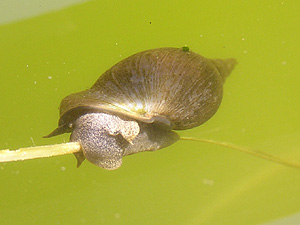
Great pond snail (Lymnaea stagnalis). [RN]
 Great pond snail (Lymnaea stagnalis). [RN] |
Class: Gastropoda
![]() Subclass: Pulmonata
Subclass: Pulmonata
![]() Superorder: Basommatophora
Superorder: Basommatophora
![]() Order: Hygrophila
Order: Hygrophila
![]() Suborder: Branchiopulmonata
Suborder: Branchiopulmonata
![]() Infraorder: Lymnaeoinei
Infraorder: Lymnaeoinei
![]() Superfamily: Lymnaeoidea
Superfamily: Lymnaeoidea
![]() Family: Lymnaeidae Rafinesque 1815
Family: Lymnaeidae Rafinesque 1815
![]() Source: Mollbase on
http://www.mollbase.de/list/.
Source: Mollbase on
http://www.mollbase.de/list/.
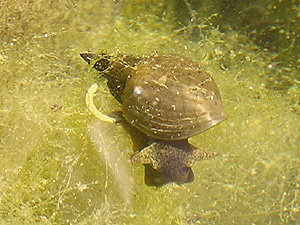 Great pond snail (Lymnaea stagnalis). [RN] |
![]() Systematic position of
pond
snails (Lymnaeidae) according to
Mollbase.
Systematic position of
pond
snails (Lymnaeidae) according to
Mollbase.
![]() Gastropoda taxonomy: Informal
group Pulmonata: Lymnaeidae.
Gastropoda taxonomy: Informal
group Pulmonata: Lymnaeidae.
Pond snails (Lymnaeidae) are a family of gastropods quite common in European rivers, lakes and ponds. The large freshwater snails also live in garden ponds and aquaria. There they are often introduced involuntarily with water plants, but also many people like to have them and so put them into their ponds on purpose.
Some species of pond snails can reach a shell size of up to 7 cm. That makes them considerably larger than the Roman snail (Helix pomatia), the largest European terrestrial snail.
Similar to frogs, pond snails can also cover part of their oxygen needs by tissue breathing. But though they live in the water, pond snails, like the Roman snail, breathe with lungs. So they have to surface to breathe from time to time. But they need not to surface entirely, as they are able to crawl on a mucus band, hanging from the water's surface.
Systematically, pond snails are water pulmonate snails (Basommatophora). They can be told apart from terrestrial pulmonate snails by having two, instead of four, tentacles, the eyes placed at their base. Hence the systematic name Basommatophora, meaning base-eye snails.
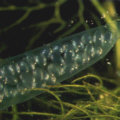 |
Like the Roman snail, pond snails also are hermaphrodites. Contrary to their terrestrial relative, pond snails have separate genital openings, so mating can only occur in one direction, not vice-versa. The characteristic egg batches of pond snails (see picture on the left) are stuck to water plants and stones.
In populations with a low number of individuals, for example after the occupation of a new water body, pond snails can also perform auto-fertilisation. But this can only serve to increase numbers. To mix genes, common sexual reproduction is necessary.
Pond snails have also been important to genetic research. Using the example of the Wandering pond snail (Radix labiata, formerly Lymnaea peregra) the American geneticist Alfred Henry Sturtevant (1891-1970) tried to understand how the coiling of the snail shell works.
As mentioned before, pond snails can also crawl at the water surface's underside on a mucus band, either to look for food or simply to get from one place to another.
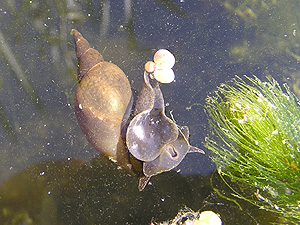
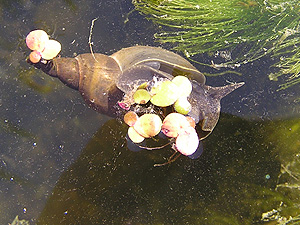
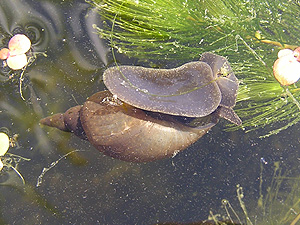 A great pond snail (Lymnaea stagnalis) crawling on a mucus band at the water surface's underside. [RN] |
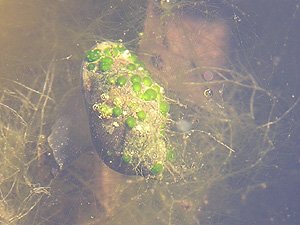 An egg-shaped pond snail (Radix balthica). [RN] |
Great pond snail - Lymnaea stagnalis
Giant forms of this species can grow to 7 cm shell size, but depending on the environmental conditions in waterside habitats there can also be dwarf forms. The shell spire is elongated and pointed, first increases slowly, but then extends strongly when forming the apertural whorl. The shell has a light horny to whitish colour, and the glossy surface is covered in fine and irregular striae (longitudinal ribs). The aperture is oval and a little higher than the remaining spire.
Dimensions: H: 50 - 60 mm; W: 25 - 30; N: 6 - 8. (Abbreviations).
The great pond snail lives in stagnant waters rich in vegetation and in alluvial river valleys, but also in many artificial water bodies. The distribution area of the species is holarctic (see Faunal provinces of the earth), it can be found from Northern Spain over all of Europe, except the southern area of the Mediterranean islands. In Asia the species lives as far east as Kashmir, Siberia, Kamchatka and also in Northern America. In Scandinavia, the great pond snail is present as far north as the 69th degree of latitude. In Tasmania and New Zealand, Lymnaea stagnalis has been introduced.
Wandering Pond snail - Radix labiata
This species has got an oval shell with straight lateral lines. The spire is conical. The shell has quite thick walls and a dark horny to brown colour, usually with black accretions on its surface. The wandering pond snail inhabits stagnant of slowly flowing waters, often very small water bodies low in limestone content. The wandering pond snail can cope much better with its water body drying out than other Radix species.
Radix labiata is present in all of Europe including the high North and Western Asia. In Switzerland (Rhaeticon) it can be found in altitudes of up to 2000 m MSL., in the Pyrenees up to 2238 m MSL. In Lake Geneva, wandering pond snails can be found in depths of up to 30 m.
Concerning the species name see: Species: Radix labiata on Mollbase: The species formerly known as Radix peregra today must be called Radix labiata.
 Big-ear pond snail (Radix auricularia). |
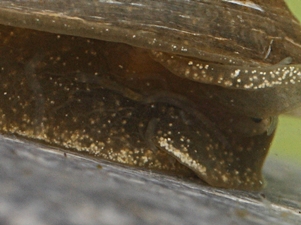 Big-ear pond snail (Radix auricularia) with a nematode infesta- tion. Pictures: © Alexander Mrkvicka, Vienna (mrkvicka.at). |
Big ear pond snail - (Radix auricularia)
The shell's last whorl is elated and widened to an ear-shape. The shell grows to a height of 35 mm. The spire is small and acute with flattened whorls. The height of the spire and the width of the apertural whorl are extremely variable, but even if the spire is shortened, the apex can be seen beyond the apertural whorl (a characteristic difference to Radix ampla). The big-ear pond snail's mantle is characteristically full of lightly coloured blotches, which can be seen through the shell wall.
Radix auricularia is found in lakes, stagnant river arms and calm river bays, in altitudes of up to 1900 m MSL. Radix auricularia can tolerate a salinity level of 0.6%.
The distribution area of this species spreads over all of Europe including the Mediterranean countries but excluding Sicily and the Peloponnesus, as well as over Western and Northern Asia.
The big-ear pond snail can be infested with nematodes, but, contrary to Galba truncatula, is not believed to be an intermediate host for parasites potentially harmful to humans.
Egg-shaped pond snail - (Radix balthica)
Much smaller than the big-ear pond snail, this species' whorls are more ventricose, the apertural whorl is less elated. The species lives in water bodies (streams, rivers and lakes) rich in limestone, in all of Europe, except Southern Spain and the Peloponnesus.
Concerning the species name see: Species: Radix balthica on Mollbase: The species formerly known as Radix ovata today must be called Radix balthica.
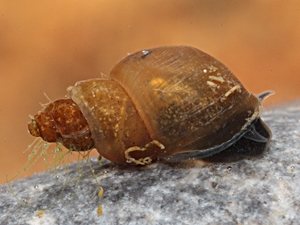 Lesser pond snail (Galba truncatula). Picture: © Alexander Mrkvicka, Vienna (mrkvicka.at). |
Lesser pond snail - Galba truncatula
 Lesser pond snail (Galba truncatula) on land. Picture: © Stefan Haller, (schneckenfoto.ch). |
A very small snail, whose shell whorls are set apart like stair steps. Usually, the shell is between 6 and 8 mm high, but there are also dwarf and giant forms between 3 and 15 mm.
The lesser pond snail lives in small and tiny water bodies, such as moats and puddles. Often, this snail will leave the water and then hides below beech leaves on the ground. The distribution area of the lesser pond snail covers all of Europe, North Africa, West and North Asia and Alaska.
The small pond snail is well known to be the intermediate host of the liver fluke (Fasciola hepatica), but also of other mammal parasites, such as Fascioloides magna, Haplometra cylindracea and Muellerius capillaris.
![]() Francisco Welter-Schultes:
Galba truncatula species homepage.
Francisco Welter-Schultes:
Galba truncatula species homepage.
Large and big. The shell's whorls are slightly rounded and the apertural whorl predominates largely. The shell originally and basically has a horny brown colour but usually is covered in black accretions, which has given the snail its name. Especially small specimens can hardly be told apart from other Stagnicola species.
 Raven pond snail (Stagnicola corvus). Picture: © Angie Opitz, A Tyrol natural garden, Pillersee Valley, Tyrol. |
The raven pond snail lives in stagnant waters of any kind (hence the name Stagni-cola) rich in vegetation, from large lakes to swampy ponds silting up. The species' distribution area spreads from Southern Scandinavia over Central Europe to South-eastern Europe.
Complete species list for the United Kingdom and Ireland:
According to Anderson, R. (2008):
Annotated List of the Non-Marine Mollusca of Britain and Ireland (January 2008)
Lymnaeidae Rafinesque 1815
Lymnaeinae Rafinesque 1815
Galba Schrank 1803
Galba truncatula (O.F. Müller 1774)
Stagnicola Jeffreys 1830
Stagnicola palustris (O.F. Müller 1774) *)
Stagnicola fuscus (C. Pfeiffer 1821) *)
Stagnicola corvus (Gmelin 1791)Omphiscola Rafinesque 1819
Omphiscola glabra (O.F. Müller 1774)
Radix Montfort 1810
Radix auricularia auricularia (Linnaeus 1758)
Radix labiata (Rossmässler 1835) **)
Radix balthica (Linnaeus 1758)Myxas G.B. Sowerby 1822
Myxas glutinosa (O.F. Müller 1774)
Lymnaea Lamarck 1799
Lymnaea stagnalis (Linnaeus 1758)
_____________________________
*) Ireland only.
**) United Kingdom only.
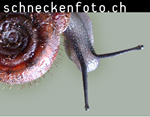 With pictures by Stefan Haller: http://www.schneckenfoto.ch. |